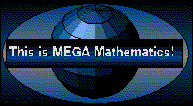


In two dimensions, topologists imagine figures that can be stretched and pulled as though they were drawn on an infinitely thin, infinitely stretchable material that can be deformed in any way (not including tearing, perforating, or gluing). Some properties that are important in Euclidean geometry such as distance, measurement of angles, or straightness are don't hold. Other properties, such as whether lines intersect or whether figures are closed (like the letter "O" ) or open (like the letter "U") remain important.
In two dimensions, a triangle, a square, and a circle are all topologiclaly equivalent. So are the upper case letters "T", "F" and "E".
In 3 dimensions, the surface of a cube, a pyramid, and a sphere are topologically equivalent. A stretchable "skin" that covers any one of them can be restretched to cover any of the others. The surface of a donut and a coffee cup are topologically equivalent--each is a three-dimensional object with a hole in it. This is an unusual (but valid) way to think about the world.
Topologists, then, are interested in a variety of surfaces. They try to understand exactly what it is that distinguishes one surface from another, and to understand the relationships that a surface can have with the space that it occupies. The mathematical study of knots is a branch of topology. The idea of a Seifert Surface also comes from Knot Theory (with a little bit of bubble-blowing thrown in!)
Topologists don't limit themselves to the three dimensional world with which we are familiar. Many of the concepts and theorems in topology deal with many-dimensional surfaces which exist only in the imagination.
The story Mort and Nort was inspired by thinking about topology.


